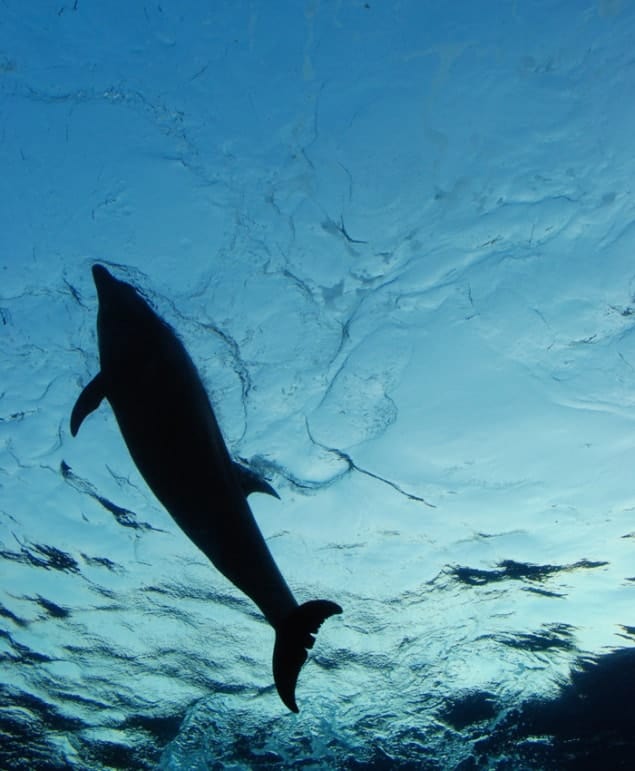
Dolphins may rely on a nonlinear analysis method to “see” through clouds of bubbles that they create to trap fish, according to scientists at the University of Southampton in the UK. The researchers have devised a nonlinear sonar processing scheme that enables them to identify targets through clouds of bubbles, opening up the possibility that dolphins may employ similar tactics when they hunt by creating bubble nets that disorient their prey.
Unlike solid objects such as the sea floor or fish – which reflect acoustic signals linearly, as straight-forward echoes – bubbles reflect nonlinearly. This means that acoustic echoes from bubbles contain harmonic frequencies in addition to the fundamental frequencies of the outgoing signal – producing a “clutter” that is incredibly confusing to sonar. And to make matters worse, bubbles are extremely efficient at reflecting sound.
“Bubbles are the most powerful naturally occurring acoustic objects in water,” explains team member Timothy Leighton. “When you send sound at them, they’ll emit sound rather like any instrument would – if you shout at a guitar, the strings will rattle back at you.”
Blinded by bubbles
Given this, Leighton was taken aback when he saw a wildlife documentary showing dolphins purposely blowing nets of bubbles to catch fish. “There should be no way the dolphins’ sonar can get through these bubbles – it’s like they’re making fog while hunting and blinding their own sonar,” he says. “Unless there’s something spectacularly good about their sonar that we haven’t discovered yet.”
Considered alongside manmade sonar devices, a dolphin’s sonar equipment appears fairly mediocre in terms of the frequencies it can cover and the power it can generate. Dolphins’ agility and speed in the water lends them the advantage of being able to send sonar from a number of different directions and thereby see in 3D, but, even so, the bubble problem remains.
“They’ve got these huge brains though, and they’ve been living in the oceans for 10 million years where there’s always bubble clutter. Why shouldn’t they have developed a way of navigating it?” asks Leighton.
Mathematical minds
Inspired by dolphins, Leighton has spent the last decade attempting to design a sonar scheme that can penetrate bubble clouds. His most recent proposal focuses on the variation in amplitude between the successive clicking sounds that dolphins are known to make as they use echolocation.
If a dolphin sends out two successive clicks, with the second being 1/3 the amplitude of the first, a fish will return faithful echoes of these sounds while a bubble will mainly return sounds in the second harmonic at a specific amplitude. For example, if the original clicks are sent with amplitudes of 1 and 1/3, respectively, then a fish will return sounds with amplitudes of 1 and 1/3, while a bubble will return sounds with amplitudes 1 and 1/9.
In Leighton’s scheme, the sonar processor (or dolphin) multiplies the second returned click by 3 and then chooses to add or subtract this from the amplitude of the first returned click. In the sum, the linear echo from the fish is accentuated; in the subtraction, the nonlinear echo is suppressed a little, but the linear echo from the fish disappears altogether. Comparing these two pictures allows the receiver to distinguish between fish and bubbles.
When Leighton and colleagues tested this theory out in a 200-tonne tank of water with a sonar source that produced dolphin-like click trains, they found that, indeed, they were able to “see” a target within a cloud of bubbles. Although this proves nothing about the tactics dolphins employ, it shows that it is possible for dolphin pulses to see through bubble clouds, given the right processing.
Behaviour bypass
But is it plausible that dolphins’ brains recognize that bubbles and fish scatter sound differently, and that they then subconsciously add and subtract echoes to distinguish targets from bubbles? Simon Ingram, a dolphin biologist at the University of Plymouth’s Marine Institute in the UK wonders if the underwater acousticians might have missed the biological point slightly.
“We need to zoom out and think about the biology behind this particular foraging method. Dolphins cast a bubble net around a concentrated ball of fish that they’ve already worked cooperatively to aggregate together,” he says. “Why do they even need to be able to see the individual fish inside that bubble curtain?”
Once the net is created, he suggests, the dolphins could pierce it at speed and snatch their prey using echolocation once they are within it.
Field observations needed
Sonar expert Hugh Griffiths of University College London says he has “huge admiration” for the work, which he labels “very novel”.
“I think you would need to do quite a bit more work before you could say for certain that dolphins are using this, but it’s certainly plausible,” he says. Along with Ingram and the Southampton team, he agrees that field observations are the next step in either adding weight to or ruling out the theory.
If wild dolphins can be recorded dropping the frequency of their sounds while employing the bubble-net hunting strategy – specifically to at least half that of their upper hearing limit – it would be a strong indication that they could be using nonlinear processing. But even then, says Leighton, a conclusive answer might prove elusive.
“It’s an extremely difficult thing to do, to work out what mental signal processing a creature such as a dolphin does. Controlling an activity where you’ve got 200 dolphins blowing nets, snapping away with their teeth in the wild and not interfering in that process while you make a measurement – you can see it’s almost impossible to do.”
The work is published in the Proceedings of the Royal Society A.



